Biology Assignment: Blood Glucose Regulation and Nerve Action Analysis
VerifiedAdded on 2020/06/04
|5
|794
|130
Homework Assignment
AI Summary
This biology assignment explores two key concepts: the homeostatic regulation of blood glucose levels and a comparison of the modes of action of nerves and hormones. The assignment details the roles of insulin and glucagon in maintaining blood glucose balance, explaining how these hormones work together to manage glucose levels after food consumption. It also contrasts the nervous and hormonal systems, highlighting differences in response time, information flow, and specificity of action. The assignment references scientific literature to support the presented information. This student submission is available on Desklib, a platform offering AI-powered study tools and resources for students, including past papers and solved assignments.
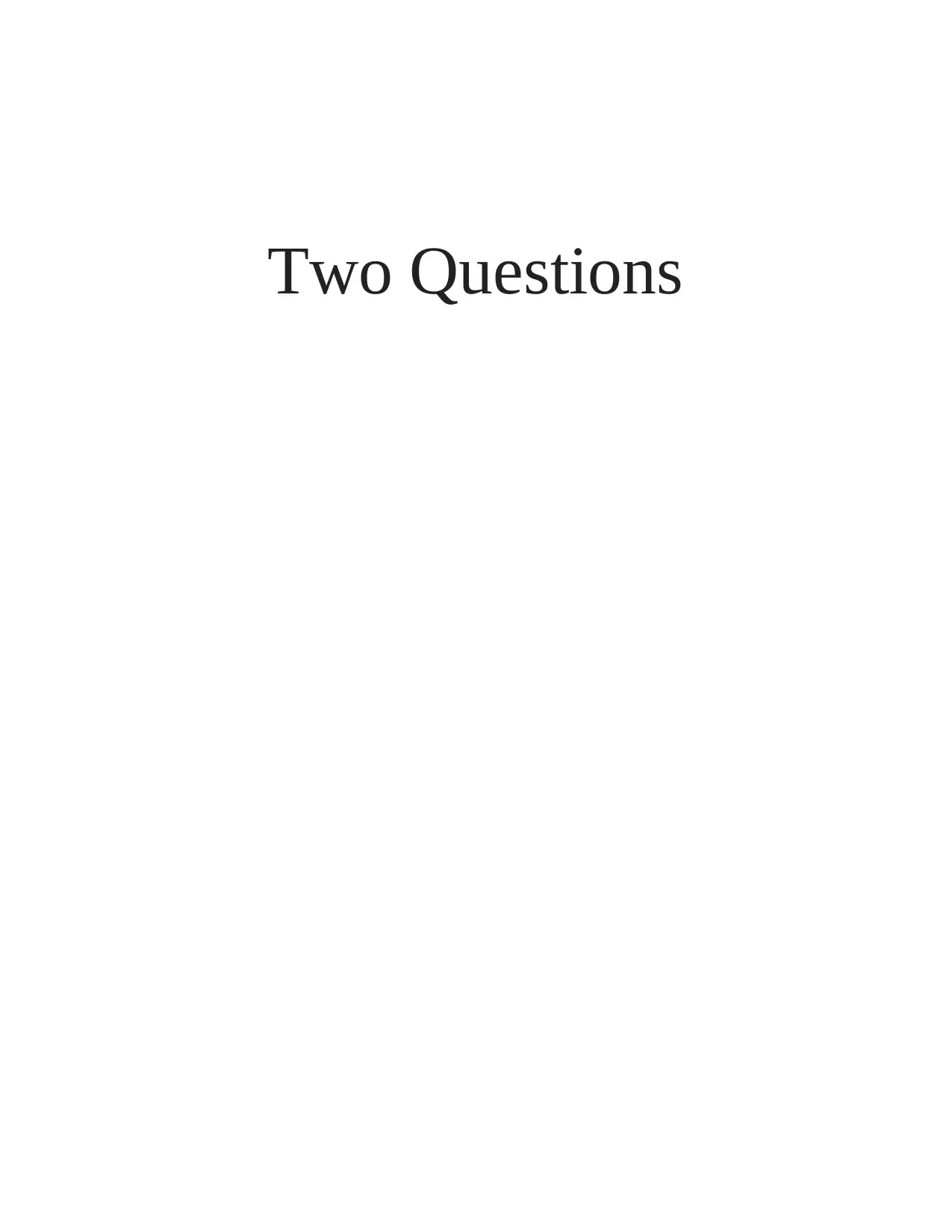
Two Questions
Paraphrase This Document
Need a fresh take? Get an instant paraphrase of this document with our AI Paraphraser
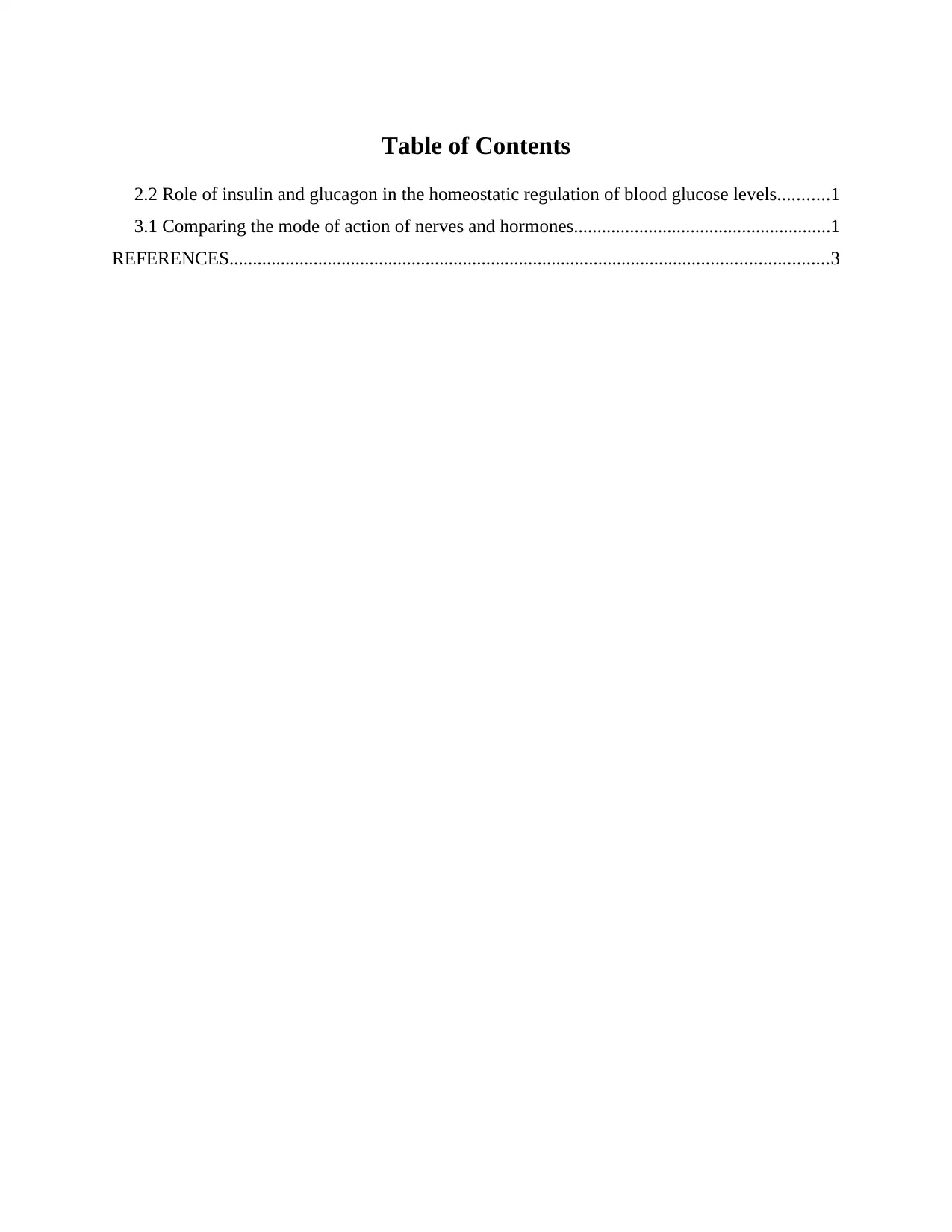
Table of Contents
2.2 Role of insulin and glucagon in the homeostatic regulation of blood glucose levels...........1
3.1 Comparing the mode of action of nerves and hormones.......................................................1
REFERENCES................................................................................................................................3
2.2 Role of insulin and glucagon in the homeostatic regulation of blood glucose levels...........1
3.1 Comparing the mode of action of nerves and hormones.......................................................1
REFERENCES................................................................................................................................3
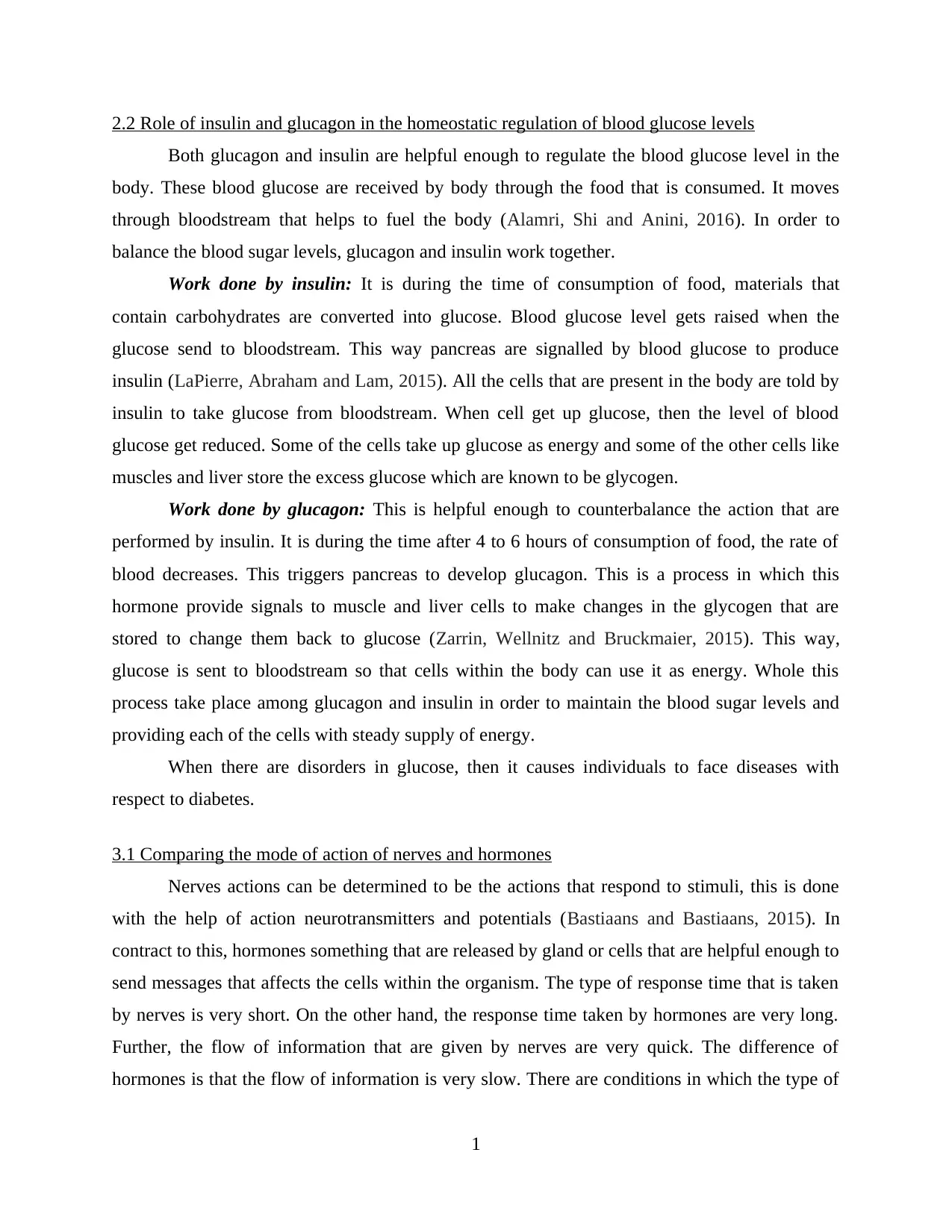
2.2 Role of insulin and glucagon in the homeostatic regulation of blood glucose levels
Both glucagon and insulin are helpful enough to regulate the blood glucose level in the
body. These blood glucose are received by body through the food that is consumed. It moves
through bloodstream that helps to fuel the body (Alamri, Shi and Anini, 2016). In order to
balance the blood sugar levels, glucagon and insulin work together.
Work done by insulin: It is during the time of consumption of food, materials that
contain carbohydrates are converted into glucose. Blood glucose level gets raised when the
glucose send to bloodstream. This way pancreas are signalled by blood glucose to produce
insulin (LaPierre, Abraham and Lam, 2015). All the cells that are present in the body are told by
insulin to take glucose from bloodstream. When cell get up glucose, then the level of blood
glucose get reduced. Some of the cells take up glucose as energy and some of the other cells like
muscles and liver store the excess glucose which are known to be glycogen.
Work done by glucagon: This is helpful enough to counterbalance the action that are
performed by insulin. It is during the time after 4 to 6 hours of consumption of food, the rate of
blood decreases. This triggers pancreas to develop glucagon. This is a process in which this
hormone provide signals to muscle and liver cells to make changes in the glycogen that are
stored to change them back to glucose (Zarrin, Wellnitz and Bruckmaier, 2015). This way,
glucose is sent to bloodstream so that cells within the body can use it as energy. Whole this
process take place among glucagon and insulin in order to maintain the blood sugar levels and
providing each of the cells with steady supply of energy.
When there are disorders in glucose, then it causes individuals to face diseases with
respect to diabetes.
3.1 Comparing the mode of action of nerves and hormones
Nerves actions can be determined to be the actions that respond to stimuli, this is done
with the help of action neurotransmitters and potentials (Bastiaans and Bastiaans, 2015). In
contract to this, hormones something that are released by gland or cells that are helpful enough to
send messages that affects the cells within the organism. The type of response time that is taken
by nerves is very short. On the other hand, the response time taken by hormones are very long.
Further, the flow of information that are given by nerves are very quick. The difference of
hormones is that the flow of information is very slow. There are conditions in which the type of
1
Both glucagon and insulin are helpful enough to regulate the blood glucose level in the
body. These blood glucose are received by body through the food that is consumed. It moves
through bloodstream that helps to fuel the body (Alamri, Shi and Anini, 2016). In order to
balance the blood sugar levels, glucagon and insulin work together.
Work done by insulin: It is during the time of consumption of food, materials that
contain carbohydrates are converted into glucose. Blood glucose level gets raised when the
glucose send to bloodstream. This way pancreas are signalled by blood glucose to produce
insulin (LaPierre, Abraham and Lam, 2015). All the cells that are present in the body are told by
insulin to take glucose from bloodstream. When cell get up glucose, then the level of blood
glucose get reduced. Some of the cells take up glucose as energy and some of the other cells like
muscles and liver store the excess glucose which are known to be glycogen.
Work done by glucagon: This is helpful enough to counterbalance the action that are
performed by insulin. It is during the time after 4 to 6 hours of consumption of food, the rate of
blood decreases. This triggers pancreas to develop glucagon. This is a process in which this
hormone provide signals to muscle and liver cells to make changes in the glycogen that are
stored to change them back to glucose (Zarrin, Wellnitz and Bruckmaier, 2015). This way,
glucose is sent to bloodstream so that cells within the body can use it as energy. Whole this
process take place among glucagon and insulin in order to maintain the blood sugar levels and
providing each of the cells with steady supply of energy.
When there are disorders in glucose, then it causes individuals to face diseases with
respect to diabetes.
3.1 Comparing the mode of action of nerves and hormones
Nerves actions can be determined to be the actions that respond to stimuli, this is done
with the help of action neurotransmitters and potentials (Bastiaans and Bastiaans, 2015). In
contract to this, hormones something that are released by gland or cells that are helpful enough to
send messages that affects the cells within the organism. The type of response time that is taken
by nerves is very short. On the other hand, the response time taken by hormones are very long.
Further, the flow of information that are given by nerves are very quick. The difference of
hormones is that the flow of information is very slow. There are conditions in which the type of
1
⊘ This is a preview!⊘
Do you want full access?
Subscribe today to unlock all pages.

Trusted by 1+ million students worldwide
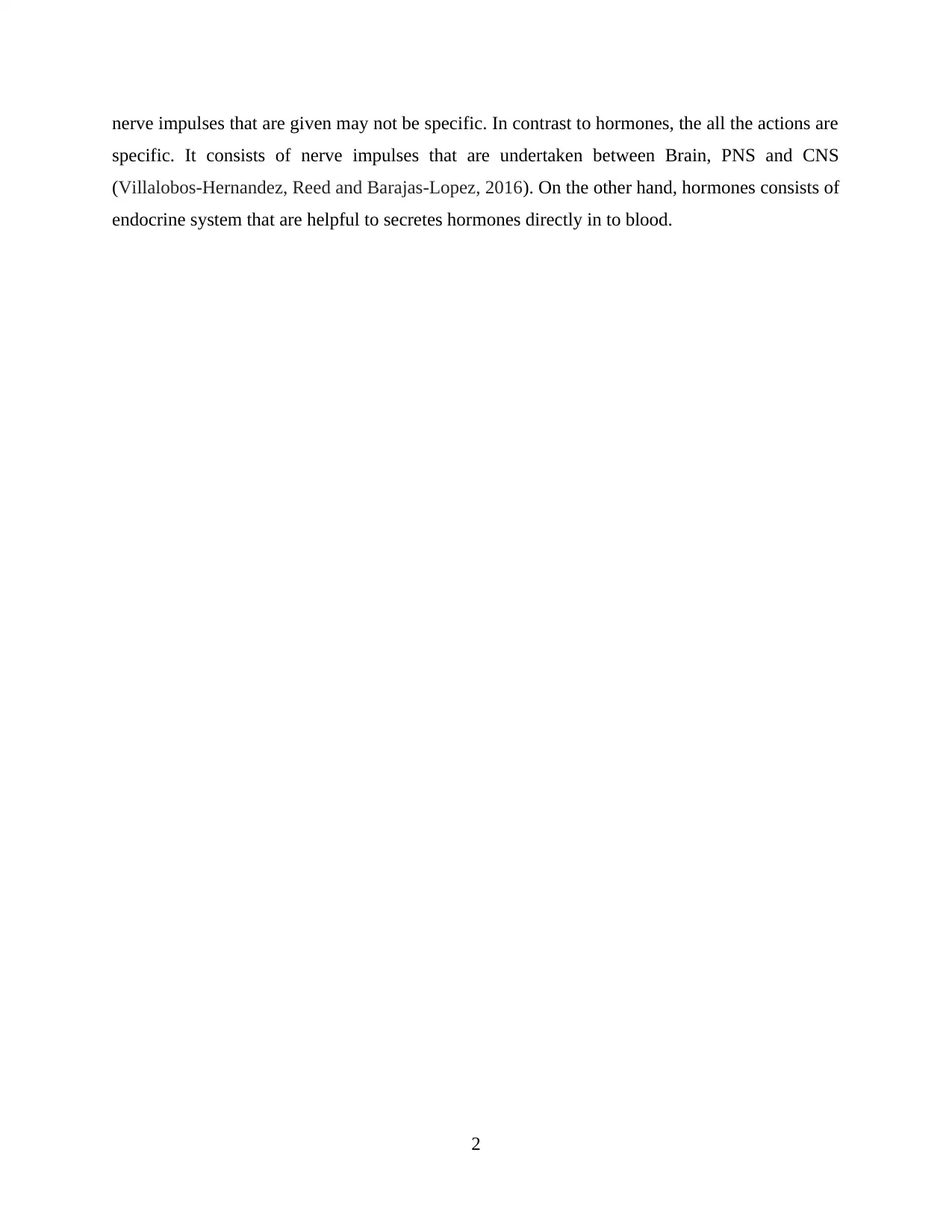
nerve impulses that are given may not be specific. In contrast to hormones, the all the actions are
specific. It consists of nerve impulses that are undertaken between Brain, PNS and CNS
(Villalobos-Hernandez, Reed and Barajas-Lopez, 2016). On the other hand, hormones consists of
endocrine system that are helpful to secretes hormones directly in to blood.
2
specific. It consists of nerve impulses that are undertaken between Brain, PNS and CNS
(Villalobos-Hernandez, Reed and Barajas-Lopez, 2016). On the other hand, hormones consists of
endocrine system that are helpful to secretes hormones directly in to blood.
2
Paraphrase This Document
Need a fresh take? Get an instant paraphrase of this document with our AI Paraphraser
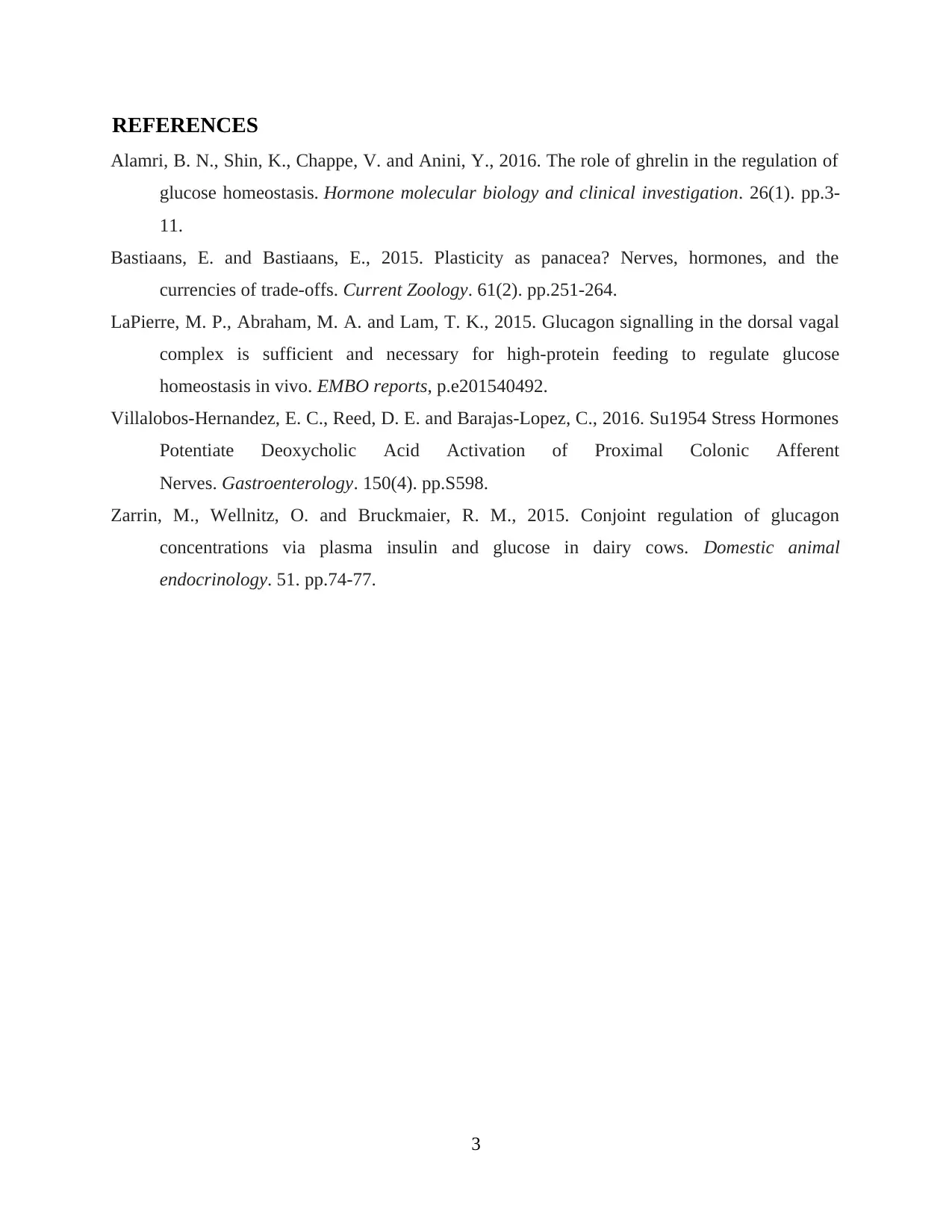
REFERENCES
Alamri, B. N., Shin, K., Chappe, V. and Anini, Y., 2016. The role of ghrelin in the regulation of
glucose homeostasis. Hormone molecular biology and clinical investigation. 26(1). pp.3-
11.
Bastiaans, E. and Bastiaans, E., 2015. Plasticity as panacea? Nerves, hormones, and the
currencies of trade-offs. Current Zoology. 61(2). pp.251-264.
LaPierre, M. P., Abraham, M. A. and Lam, T. K., 2015. Glucagon signalling in the dorsal vagal
complex is sufficient and necessary for high‐protein feeding to regulate glucose
homeostasis in vivo. EMBO reports, p.e201540492.
Villalobos-Hernandez, E. C., Reed, D. E. and Barajas-Lopez, C., 2016. Su1954 Stress Hormones
Potentiate Deoxycholic Acid Activation of Proximal Colonic Afferent
Nerves. Gastroenterology. 150(4). pp.S598.
Zarrin, M., Wellnitz, O. and Bruckmaier, R. M., 2015. Conjoint regulation of glucagon
concentrations via plasma insulin and glucose in dairy cows. Domestic animal
endocrinology. 51. pp.74-77.
3
Alamri, B. N., Shin, K., Chappe, V. and Anini, Y., 2016. The role of ghrelin in the regulation of
glucose homeostasis. Hormone molecular biology and clinical investigation. 26(1). pp.3-
11.
Bastiaans, E. and Bastiaans, E., 2015. Plasticity as panacea? Nerves, hormones, and the
currencies of trade-offs. Current Zoology. 61(2). pp.251-264.
LaPierre, M. P., Abraham, M. A. and Lam, T. K., 2015. Glucagon signalling in the dorsal vagal
complex is sufficient and necessary for high‐protein feeding to regulate glucose
homeostasis in vivo. EMBO reports, p.e201540492.
Villalobos-Hernandez, E. C., Reed, D. E. and Barajas-Lopez, C., 2016. Su1954 Stress Hormones
Potentiate Deoxycholic Acid Activation of Proximal Colonic Afferent
Nerves. Gastroenterology. 150(4). pp.S598.
Zarrin, M., Wellnitz, O. and Bruckmaier, R. M., 2015. Conjoint regulation of glucagon
concentrations via plasma insulin and glucose in dairy cows. Domestic animal
endocrinology. 51. pp.74-77.
3
1 out of 5
Related Documents
Your All-in-One AI-Powered Toolkit for Academic Success.
+13062052269
info@desklib.com
Available 24*7 on WhatsApp / Email
![[object Object]](/_next/static/media/star-bottom.7253800d.svg)
Unlock your academic potential
Copyright © 2020–2025 A2Z Services. All Rights Reserved. Developed and managed by ZUCOL.





